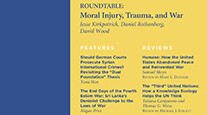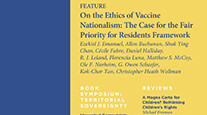Each year, nearly six million people in the developing world die of malaria, tuberculosis, and HIV/AIDS. Yet, of the $70 billion spent annually worldwide on pharmaceutical research and development (R&D), only about 10 percent is focused on finding vaccines and drug treatments for diseases affecting 90 percent of the global population. Michael Kremer and Rachel Glennerster address this alarming disparity in Strong Medicine: Creating Incentives for Pharmaceutical Research on Neglected Diseases. They employ empirical data about neglected diseases and the current pharmaceutical market to draw support for a scheme encouraging vaccine development for such diseases.
The current system of rewarding pharmaceutical innovation through exclusive patents fails to create incentives to produce drugs and vaccines for diseases primarily affecting the poor. Pharmaceutical companies must invest heavily into R&D, and will do so only insofar as they expect to recoup expenses and make a profit from sales of the final product. So even if a successful vaccine for preventing malaria were to be developed, pharmaceutical companies would be unable to make a profit on it, since their potential buyers, the poor, could not afford the vaccine at any but very low prices.
Against this backdrop, the authors suggest creating a scheme that offers new incentives for research on diseases disproportionately affecting the poor, with the goal of making development of neglected disease vaccines a lucrative endeavor for pharmaceutical companies. The basic idea is to fund prizes that would be awarded as follows: If the desired vaccine was developed, a sponsor would be committed to purchasing a minimum amount at a given price per unit. After a set amount of vaccines had been purchased, the inventor firm would be required to lower the price of the vaccine to just above its manufacturing cost, thereby granting access to the poor. Even with the vaccine eventually being sold cheaply, if the purchasing commitment were set at a sufficiently high level in terms of price and quantity, it would allow inventor firms to recoup their R&D expenses and to make a considerable profit, which would be set high enough to offset the risks of failure.
The authors justify their exclusive focus on vaccines by their greater cost-effectiveness in comparison to drugs. Curative treatments for neglected diseases, they point out, are both expensive and often difficult to administer in poor countries due to improper monitoring of patients’ treatment adherence and patients’ quick development of resistance. In contrast, vaccines are a desirable alternative because they are much cheaper and easier to administer. Additionally, they contribute to containing the spread of the disease, thus benefiting others beyond the vaccinated individual.
While vaccines are appealing, they are certainly not sufficient to eradicate the disease burden in the developing world. Kremer and Glennerster’s scheme does not address the current lack of incentives to develop treatments for neglected diseases, nor the inability of the poor to access already developed but unaffordable drugs that could save millions of lives annually. In this sense, vaccine commitments should be regarded as a program with likely benefits, but not as a comprehensive solution to the current market failures in the medical field. By focusing solely on preventive treatments for specified diseases, these commitments do not offer pharmaceutical companies the flexibility to develop alternative solutions that may be more cost-effective than those specified by the sponsors.
It would be interesting to examine how the proposed vaccine commitment scheme measures up against other ways of incentivizing R&D in the area of neglected diseases. One alternative is an international health fund that rewards new drugs and vaccines according to their impact upon the global disease burden. As with vaccine commitments, inventor firms would be paid on the basis of results, but without specific product guidelines they would have greater flexibility to choose the concentration of their research, and thus the focus would shift from the mere means of drug or vaccine creation to the ultimate end of disease reduction. While this scheme may avoid the constraints on inventor firms to meet stringent specifications set by sponsors, it has the disadvantage of providing less predictability for inventor firms. Companies would face greater risks because, even if they are the first to develop a useful drug, they may still not be able to recoup their expenses because of unforeseen circumstances that might prevent the use of the drug from alleviating the global disease burden.
The final chapter of the book discusses how to move forward with vaccine commitments. This discussion raises two major questions: First, who will fund them? And second, how can the scheme be brought into operation? In considering potential sponsors, Kremer and Glennerster conclude that the most likely and capable candidates for this endeavour are rich-country governments and multilateral organizations, such as the World Bank. Turning to the second question, they conclude: “Despite wide-spread enthusiasm, no vaccine commitment has been put in place. This is in part because there is no ready-made political constituency with a strong interest in such a commitment . . . a vaccine commitment would need a political champion to move forward” (pp. 118–19). Having formulated a detailed and well-constructed plan to create incentives for pharmaceutical companies to broaden the scope of R&D efforts, the authors do not offer constructive discussion of how vaccine commitments might be made politically appealing to sponsors. Their work is valuable in its consideration of correcting the current market failure that harms the poor, but the issue of how potential sponsors themselves may have political incentives to make substantial commitments of the kind proposed is one that requires consideration.
The authors’ pessimism regarding timely political action may be justified by the current lack of attention to the global health crisis, but they are too quick to discount the likelihood of moving forward with vaccine commitments. Affluent nations’ governments are expected to be resistant to sponsoring vaccine commitments because they see them as benefiting the poor abroad but not their own constituencies. In an era of significant global economic and political interaction, however, the elimination of large concentrations of disease, resulting in more stable regional economies by allowing poor areas to develop with healthier and more productive populations, would have benefits to the developed world. In addition, Western governments would be seen as supporting a measure that effectively addresses the suffering of the poor, bolstering their own image. In light of the ever-increasing gap between the rich and the poor, a good-faith effort to address seriously the health and poverty concerns of the poor countries can play an important role in reducing anti-Americanism, which may have positive implications on security and terrorism concerns.
It might also be useful to contrast the cost-effectiveness of this scheme with various forms of aid and loans to poor countries. Securing greater commitments to aid and loans has become increasingly difficult, as critics point to the lack of results despite the significant sum of money transferred to the developing world over the years. A plan of vaccine commitments avoids two of the primary issues that render aid ineffective. First, aid can have the potential pitfall of paying for a worthwhile public project, but in doing so endowing corrupt governments with funds (that might otherwise have been used for public purposes) to spend for less desirable objectives, such as building personal militias. In the case of vaccine commitments, money spent by rich-country governments goes directly to vaccine creators, and the good being distributed to the poor is vaccines themselves, which unlike money is a nonfungible good—that is, the distribution of vaccines to a population cannot be translated into benefits to be enjoyed by a corrupt government. Second, aid is often criticized for being ineffective, as it is filtered through bureaucracy and thus only a low proportion of it actually reaches its intended recipients. Unlike direct funding for a specific project, which is the typical structure of aid and loans, vaccine commitments do not dole out money and hope for fruitful returns, but rather pay strictly on the basis of results. Therefore, the cost-effectiveness of vaccine commitments, which promise money only insofar as vaccines that impact upon health are delivered, is expected to be much higher than that of typical aid and loans by avoiding the uncertainty of success after payment. These issues all deserve further attention, because innovative programs like the one sketched out in this book have no chance of implementation until long-term political commitments from potential sponsors can be secured.
—REKHA NATH, Centre for Applied Philosophy and Public Ethics, Australian National University



